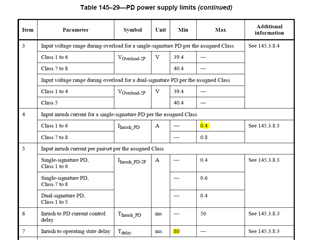Other Parts Discussed in Thread: TPS23753,
In datasheet of TPS23753A, Vc is introduced as follows, which mentions that Cvc requires a minimum of 0.22uF, and a larger total capacitance is required to start. The design manual of TPS23753 also mentions that the total capacitance affects the startup time and reduces the frequency of hiccup mode.


The current average power consumption of security is about 3W, and the peak power consumption is 10W. The design Cvc1 uses a 22uF aluminum electrolytic capacitor, and Cvc2 uses a 1uF ceramic capacitor.
I would like to ask the supplier, what are the risks if Cvc1 is replaced with a 10uF aluminum electrolytic capacitor? What is the main impact of startup time? What effect does it have on hiccup mode?




